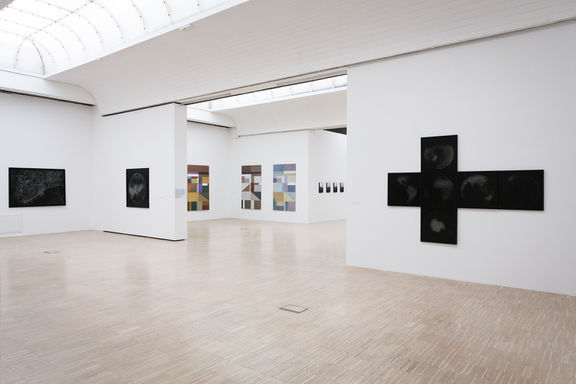Koroška Gallery of Fine Arts, Slovenj Gradec
Koroška galerija likovnih umetnosti Slovenj GradecMuseum of Modern and Contemporary Art Koroška
-
to
12 Jul 2021
31 Dec 2021
Slovenian contemporary visual arts exhibition We Live in Interesting Times, curated by Marko Košan, on the occasion of Slovenian Presidency of the Council of the European Union, coorganised by the Ministry of Culture, Museum of Modern and Contemporary Art Koroška in Slovenj Gradec, and the European Parliament,
-
13 Jun 2017
A presentation of the The Second Explosion - Slovene Art of the 1990s research project and book launch by artist and curator Tadej Pogačar and photographer Dejan Habicht, coorganised by the P.A.R.A.S.I.T.E. Institute, Koroška Gallery of Fine Arts and the educational program for young curators INCUBATOR,
-
to
8 Dec 2016
9 Dec 2016
Mateja Lazar of the Creative Europe Desk Slovenia (Motovila Institute) and Andreja Hribernik (Koroška Gallery of Fine Arts) at the Creative Georgia Forum
-
to
25 Oct 2013
1 Dec 2013
Transfer > Slowenien, a joint exhibition organised in the framework of an artists-in-residence exchange programme between Slovenia and Upper Bavaria also featuring works by Katja Felle, Jure Markota, and Uroš Weinberger (Koroška Gallery of Fine Arts),
-
to
19 Sep 2013
13 Oct 2013
The joint exhibition Augenräume - contemporary art from the Koroška region - by Zoran Ogrinc, Luka Popič, and Peter Hergold, and curated by Marko Košan (Koroška Gallery of Fine Arts),
Its international art collection is the result of donations, bequests and purchases, and consists of paintings, prints, photographs, original architectural drawings, statues, and documentary material on installations, including performances and other audio-visual forms of contemporary presentation. A range of internationally-famous artists is represented, including Ossip Zadkine, Victor Vasarely, Maria Bonomi, Toon Wegner, Gene Chu and Paolo Minoli. The installation of the international art collection is not fixed but changes several times a year, with every new installation presenting about a hundred works.
The gallery's collection of works by Slovene artists reflects several decades of the gallery's exhibitions programme, and features the work of Marko Šušteršič, France Mihelič, Riko Debenjak, Marjan Pogačnik, Božidar Jakac, Ive Šubic, Rudolf Kotnik, Kiar Meško, Dragica Čadež, Janez Boljka, Zdenko Huzjan and others. The most significant segment of the collection are works by artists who are natives of Carinthia or are in some way or another connected with the Mislinja, Drava or Mežica Valleys, namely Franjo Golob, Karel Pečko, Bogdan Borčić, Lojze Logar, Gustav Gnamuš, Rade Nikolić, Anton Dolenc, Vida Slivniker, Harald Draušbaher, Andrej Grošelj, Štefan Marflak, Miran Prodnik, Naca Rojnik, Peter Hergold and Sašo Vrabič.
The collection also presents the heritage from the 19th century onwards as well as the most recent art trends. A special place is occupied by the works of Franc Berneker (1874-1932), the first modern Slovene sculptor and fellow traveller of the impressionist painters, and by the works by painter Oskar Pistor (1865-1928), whose portraits, genre and landscape paintings establish links between the Upper Drava Valley and cosmopolitan Vienna and Munich, and also depict the landscapes of the Tyrol and Carinthia which inspired Pistor. Also featured is painter Jože Tisnikar (1928-1998), who matured as an artist while suffering traumatic experiences in a hospital pathology department and whose work is best defined by the term 'dark modernism'; 43 paintings and drawings present the artist's development from the early years to maturity and, together with documentary material on the artist's life, reveal Tisnikar's world from different angles, examining his iconographic theme of death and highlighting his particular nature.
The former Yugoslav Culture Room has a rich collection of works by Krsto Hegedušić, Vlado Jakelić, Pedja Milosavljević, Miljenko Bosanac, Zorislav Drempetić, Nikola Koydl, Robert Tanay, Seid Hasanefendić, Zvonko Lončarić, Branislav Dinić, Nikola Gvozdenović, Mića Popović, and others.
Works by Italian artist Pino Poggi (donated in 1998) provide the basis for a developing International Museum of Social Aesthetics. The permanent installation of Poggi's conceptual works is a project installation, in the sense that it presents individual segments of the artist's opus created in different media.
The gallery also contains the collection of Dr Franc Tretjak, who spent nearly 20 years in Africa as an economic consultant of the United Nations and donated to the town his African collection consisting of domestic artefacts (vessels, ladles, calebashes, fans, baskets, musical instruments, tools, arms, etc) and items which have an ethnological value (cult objects including masks and statuettes, fetishes and amulets, objects of white and black magic, Nomoli (Nomori) statues and rare 'antiques' from the African continent).
The open-air gallery on the edge of Štibuh Park is also arranged as a venue for cultural events. In the 1970s its cultural function was further enhanced with the installation of sculptures by selected artists (Ivan Meštrović, Drago Tršar, Josip Diminić, Jordan Grabuloski, Ivan Sabolić, Ratko Vulanović, Ana Bešlić, etc) under the slogan 'For Peace'. This gallery also focuses on contemporary art, and runs an important international changing exhibition programme.



